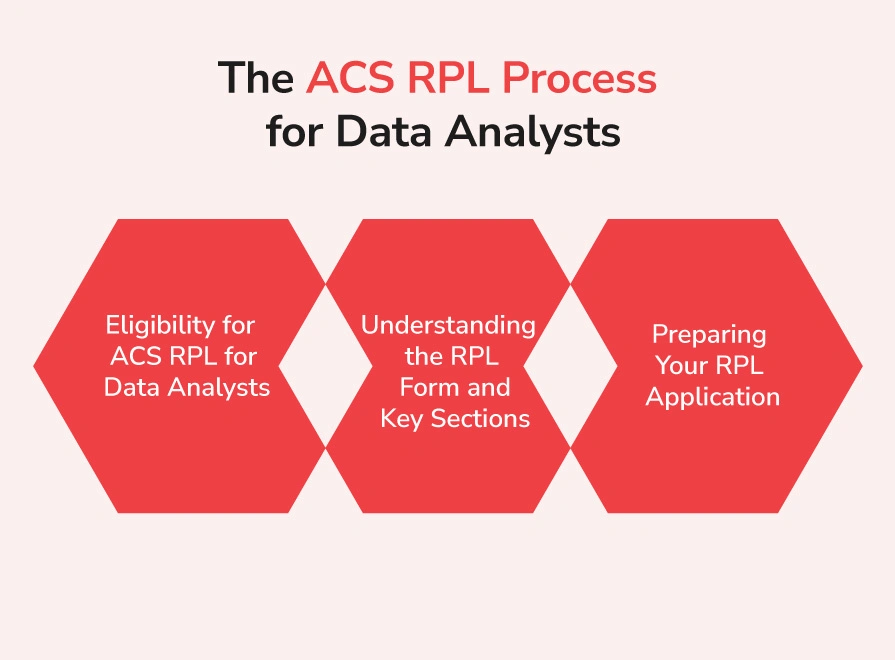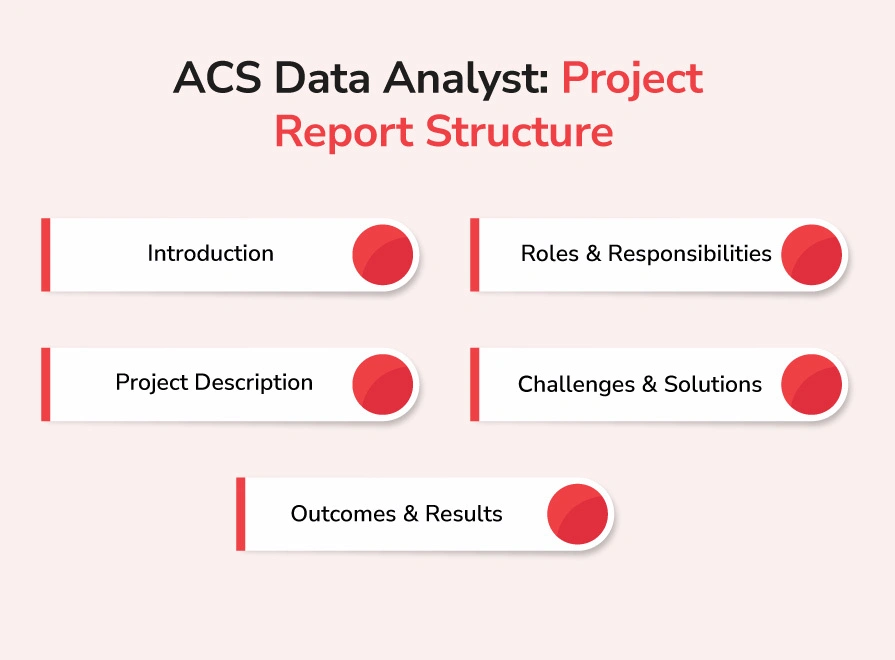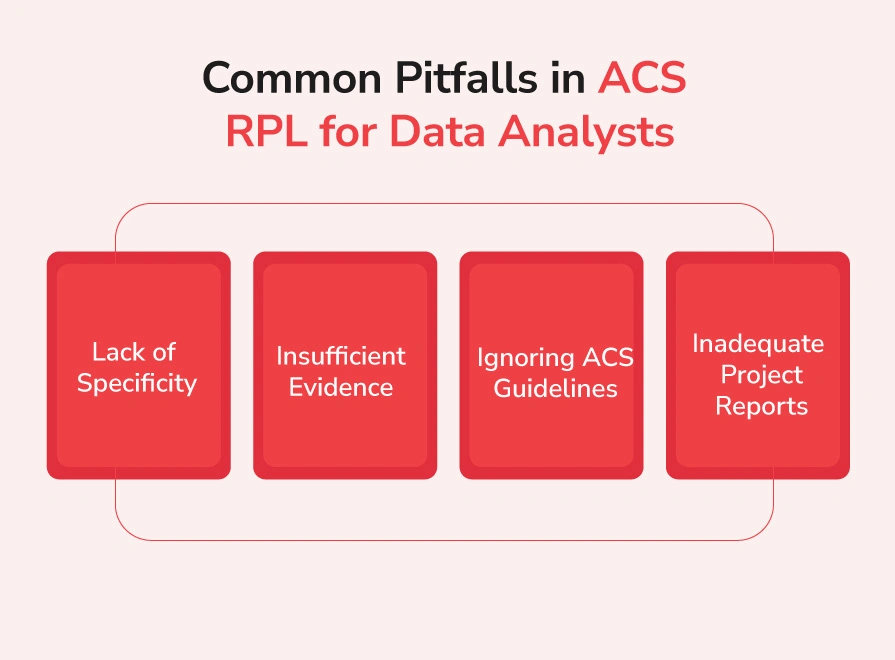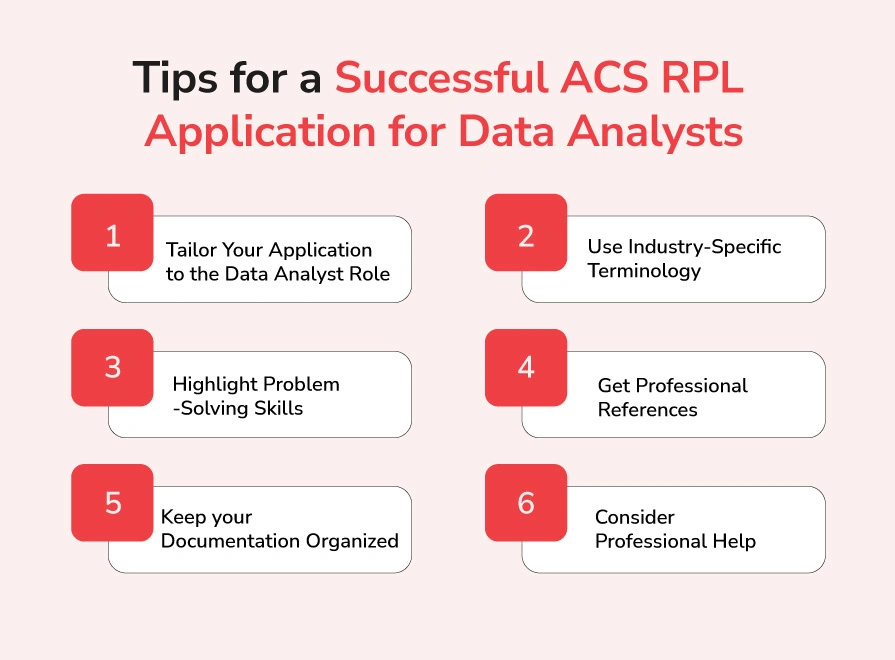
Full ACS RPL Guide: Data Analyst PR Pathway In Australia
Australia has become an in-demand destination for IT professionals, including data analysts, looking to enhance their careers and secure permanent residency (PR).
For those who lack formal qualifications but have substantial industry experience, the Australian Computer Society (ACS) provides a pathway through the Recognition of Prior Learning (RPL) process.
This guide will walk you through everything you need to know about the ACS RPL for Data Analysts, covering each step of the process, tips for a successful submission, and how this can lead to your PR in Australia.
What is ACS RPL for Data Analysts?
ACS RPL (Recognition of Prior Learning) for Data Analysts is a specialized pathway that allows IT professionals without an accredited qualification to demonstrate their knowledge and skills through documented experience.
The Australian Computer Society assesses this experience to determine if it meets the standards required for a skilled migration visa.
Data analysts play a critical role in interpreting complex data sets and transforming them into actionable insights. The ACS RPL allows those without formal education in this field to prove their competency and continue their career journey in Australia.
🔑 Key Highlight
- ACS RPL is a pathway for experienced data analysts without formal qualifications to secure PR in Australia.
- ACS RPL provides an opportunity to gain recognition for industry experience, opens doors for employment and visa approval, and serves as a pathway to permanent residency.
- Key components of ACS RPL include the RPL application form, key areas of knowledge, and project reports.
- The ACS RPL Process involves checking eligibility, familiarizing yourself with key areas of knowledge, understanding the RPL form, preparing your application, submitting and evaluating it, and taking the next steps.
Why is the ACS RPL Important for Data Analysts?
The ACS RPL for Data Analysts is vital because it opens doors for professionals who may not have traditional degrees but possess significant experience in the industry. This pathway is the only option for many to achieve PR in Australia.
As data analytics becomes increasingly essential in various sectors, the demand for skilled data analysts continues to rise. However, it can be challenging to secure employment and visa approval in Australia without the proper recognition of your skills.
The ACS RPL enables you to:
-
Demonstrate your expertise
Show that your experience and skills match the Australian standards for data analysts.
-
Secure employment
Gain the recognition needed to be considered for roles in Australia.
-
Pathway to PR
Fulfill one of the essential requirements for skilled migration visas.
The ACS RPL Process for Data Analysts

Understanding the ACS RPL process is crucial for a successful application. The process is straightforward but requires careful attention to detail and thorough documentation of your experience.
1. Eligibility for ACS RPL for Data Analysts
Before beginning the ACS RPL process, you must meet the eligibility criteria. The ACS RPL is designed for IT professionals who:
- Lack of a recognized qualification but has relevant work experience.
- Hold a qualification that is not closely related to the data analyst occupation.
Applicants with a non-ICT degree must have at least six years of work experience as an ICT professional in a field relevant to their nominated occupation (ANZSCO code).
On the other hand, applicants without tertiary qualifications need eight years of work experience as ICT-skilled employees, with at least two years relevant to the ANZSCO code.
It’s important to note that the ACS has strict requirements for the RPL report, and failure to meet these requirements can result in the rejection of your application.
Therefore, it’s essential to fully understand the ACS guidelines and regulations before preparing your RPL report. It’s also advisable to seek professional help to ensure that your RPL report meets all the requirements and is of the highest standard.
Your experience must be recent and directly related to data analytics to be considered.
2. Understanding the RPL Form and Key Sections
The ACS RPL application requires the completion of a detailed RPL form, which is divided into two sections:
- Section 1: Key Areas of Knowledge
- You must demonstrate your understanding of the core areas of ICT knowledge. This includes the fundamentals of computing, problem-solving techniques, and your ability to apply these skills in real-world scenarios.
- You’ll need to address topics like databases, networks, security, and project management, relating them to your work as a data analyst.
- Section 2: Project Reports
- You must submit two project reports that showcase your experience as a data analyst. These reports should cover projects from the last five years and demonstrate how your skills have been applied in a professional context.
- Each project report must outline the scope, objectives, your role, and the outcomes, with a strong emphasis on the technical skills used.
3. Preparing Your RPL Application
Preparation is key to a successful ACS RPL submission. Follow these steps to ensure your application stands out:
Gather Documentation
Collect all necessary documents that prove your work experience and skills. This includes reference letters, employment contracts, pay slips, and detailed job descriptions.
Write the Key Areas of Knowledge
Use the provided guidelines to address each area of knowledge. Be specific and relate your experience directly to the topics required by the ACS.
Draft the Project Reports
Your project reports are critical. Make sure they are detailed, focusing on the technical challenges you faced and how you overcame them. Highlight your problem-solving skills, use of data analytics tools, and the impact of your work on the project’s success.
Review and Proofread
Carefully review your entire application for accuracy and completeness. A single mistake could delay the processing of your application or lead to a negative outcome.
Detailed Walkthrough of the ACS RPL for Data Analyst Applications
In this section, we’ll take a closer look at how to complete each part of the ACS RPL application for data analysts.
ACS Data Analyst: Key Areas of Knowledge
The Key Areas of Knowledge section is your opportunity to show your theoretical understanding of ICT concepts that underpin data analytics. The ACS divides these areas into two categories:
- Essential Core ICT Knowledge
- General ICT Knowledge
As a data analyst, your focus should be on how these areas relate to your work. Let’s explore each in more detail.
Essential Core ICT Knowledge
ICT Professional Knowledge
This includes your understanding of ethics, professionalism, teamwork, communication, and the social implications of technology. You should illustrate how these principles have guided your work as a data analyst.
ICT Problem Solving
This involves demonstrating your ability to solve complex problems using ICT tools and methodologies. Highlight your experience with data extraction, analysis, and the application of statistical methods to drive business decisions.
General ICT Knowledge
Technology Resources
Discuss your knowledge of data storage, hardware, software, and networking as it pertains to data analysis. Explain how you’ve managed technology resources in your role.
Technology Building
This includes software development and programming. If you’ve created scripts or custom software for data processing, this is the place to detail that experience.
ICT Management
Demonstrate your understanding of project management principles and how you’ve applied them to data-driven projects. This includes the planning, execution, and evaluation of project outcomes.
ACS Data Analyst: Project Reports

Your project reports are perhaps the most critical part of your RPL application. These reports should vividly describe how you’ve applied your data analysis skills in real-world situations.
Project Report Structure
Each project report should include the following sections:
1. Introduction
Provide a brief overview of the project, including its purpose and scope.
2. Roles and Responsibilities
Describe your role in the project and your key responsibilities.
3. Project Description
Give a detailed description of the project, including the tools and technologies used.
4. Challenges and Solutions
Highlight the challenges you faced and how you addressed them using your data analysis skills.
5. Outcomes and Results
Explain the outcomes of the project and how your work contributed to its success.
Example of a Project Report for a Data Analyst
Here’s a hypothetical example to guide you:
Project Title: Customer Segmentation Analysis for a Retail Chain
Introduction: The project aimed to segment customers based on purchasing behavior to develop targeted marketing strategies.
Roles and Responsibilities: As the lead data analyst, I was responsible for data collection, preprocessing, analysis, and reporting.
Project Description: I used Python and SQL to analyze customer transaction data. The analysis involved clustering algorithms to identify distinct customer segments.
Challenges and Solutions: The main challenge was dealing with incomplete data. I implemented data-cleaning techniques and used imputation methods to handle missing values.
Outcomes and Results: The segmentation analysis resulted in three distinct customer groups, leading to a 15% increase in targeted marketing campaign effectiveness.
Common Pitfalls in ACS RPL for Data Analysts

Even with the best preparation, applicants can make mistakes that jeopardize their RPL application. Here are some common pitfalls and how to avoid them:
1. Lack of Specificity
One of the most common mistakes is not being specific enough in your responses. When describing your experience, avoid vague statements. Instead, provide detailed examples that demonstrate your skills.
Avoid: “I worked on data analysis.” Better: “I conducted a detailed analysis of sales data using Python, identifying trends that led to a 10% increase in revenue.”
2. Insufficient Evidence
Ensure that all claims made in your application are backed by evidence. This includes providing documents such as reference letters, project reports, and employment contracts.
3. Ignoring ACS Guidelines
The ACS provides specific guidelines for the RPL process. Ignoring these guidelines or failing to follow them precisely can result in your application being rejected. Make sure to review the ACS Handbook and follow it to the letter.
4. Inadequate Project Reports
Project reports that are too brief, lack technical detail, or fail to demonstrate your role in the project is likely to be rejected. Invest time in crafting comprehensive and detailed project reports.
How the ACS RPL Leads to PR in Australia
The ultimate goal of the ACS RPL process is to help you secure PR in Australia. Here’s how the process fits into the broader immigration framework:
1. Positive Skills Assessment
A successful ACS RPL submission will result in a positive skills assessment. This assessment is a key requirement for many skilled migration visas, such as the Skilled Independent Visa (Subclass 189) and the Skilled Nominated Visa (Subclass 190).
2. Expression of Interest (EOI)
Once you have a positive skills assessment, you can submit an Expression of Interest (EOI) through the Department of Home Affairs’ SkillSelect system. This EOI allows Australian states and territories to consider you for nomination, which can significantly boost your chances of receiving an invitation to apply for PR.
3. Invitation to Apply
If your EOI is selected, you will receive an invitation to apply for a visa. At this stage, you’ll need to provide further documentation, including proof of your skills assessment, English language proficiency, health checks, and character assessment. Once all requirements are met, you can submit your visa application.
4. Visa Grant and PR Status
Upon a successful visa application, you will be granted a skilled migration visa, which provides permanent residency in Australia. This allows you to live, work, and study in Australia indefinitely, with the opportunity to apply for Australian citizenship after meeting residency requirements.
Tips for a Successful ACS RPL Application for Data Analysts

Submitting a strong ACS RPL application requires more than just meeting the basic criteria. Here are some tips to help you enhance your submission:
1. Tailor Your Application to the Data Analyst Role
Ensure that your application is specifically tailored to the role of a data analyst. Your experience should reflect the key competencies expected in this profession, such as data manipulation, statistical analysis, data visualization, and the use of relevant software tools.
2. Use Industry-Specific Terminology
Using the correct industry terminology helps demonstrate your familiarity with the field. Refer to tools, methodologies, and technologies that are commonly used in data analysis, such as SQL, Python, R, data mining, machine learning, and business intelligence.
3. Highlight Problem-Solving Skills
Data analysis is all about solving problems. Make sure your project reports emphasize how you identified problems, devised solutions, and implemented them to achieve positive results. Concrete examples of your problem-solving abilities will strengthen your application.
4. Get Professional References
Strong references from employers or colleagues who can vouch for your skills and experience can significantly bolster your application. These references should be detailed and align with the information you provide in your RPL submission.
5. Keep your Documentation Organized
Organize your documents clearly and logically. Ensure that all evidence is easy to find and directly supports the claims made in your RPL application. This includes labeling documents appropriately and providing a clear structure to your submission.
6. Consider Professional Help
If you’re unsure about any aspect of the RPL process, consider seeking professional advice. There are consultants and migration agents who specialize in ACS RPL applications and can provide guidance to ensure your submission meets all requirements.
The Role of Continuous Learning and Development
In the fast-evolving field of data analytics, continuous learning is crucial. Even after obtaining a positive skills assessment and securing PR, staying up-to-date with the latest tools, technologies, and methodologies will enhance your career prospects in Australia.
1. Online Courses and Certifications
Consider enrolling in online courses or obtaining certifications in advanced data analytics, machine learning, artificial intelligence, or big data. Platforms like Coursera, edX, and Udacity offer specialized programs that can help you stay current with industry trends.
2. Networking and Professional Associations
Joining professional associations such as the Australian Computer Society (ACS) or the Institute of Analytics Professionals of Australia (IAPA) can provide valuable networking opportunities. These associations often offer professional development resources, events, and forums where you can connect with other data analysts.
3. Attending Conferences and Workshops
Participating in industry conferences, seminars, and workshops is another great way to keep your skills sharp and stay informed about the latest developments in data analytics. These events also offer opportunities to meet potential employers and collaborators.
Success Stories: How ACS RPL Helped Data Analysts Achieve PR in Australia
Hearing about the success stories of others who have gone through the ACS RPL process can be incredibly motivating. Here are a few examples of data analysts who successfully used the ACS RPL to achieve PR in Australia:
Case Study 1: From Data Analyst to Australian Resident
Rohan, a data analyst from India, had over 10 years of experience but no formal qualification in ICT. He decided to apply for the ACS RPL pathway and meticulously documented his experience, focusing on his roles in various data-driven projects.
His detailed project reports, combined with strong references from previous employers, led to a positive skills assessment. Rohan’s EOI was selected, and he was granted a Skilled Independent Visa (Subclass 189). Today he lives in Sydney and works as a senior data analyst for a major financial institution.
Case Study 2: Leveraging RPL for a Career Boost
Riol’a, originally from Brazil, had a degree in economics but found her passion in data analysis. Despite her non-ICT background, she has accumulated significant experience in data analytics through various roles. By carefully aligning her project reports with the ACS RPL requirements, she was able to secure a positive assessment.
She applied for the Skilled Nominated Visa (Subclass 190) and was nominated by the state of New South Wales. Now a permanent resident, Maria continues to thrive in her role as a data analyst in Melbourne.
Case Study 3: Achieving PR Through RPL and State Nomination
Rasid, a data analyst from Egypt, faced challenges in getting his qualifications recognized in Australia. He opted for the ACS RPL route and highlighted his extensive experience with data modeling, statistical analysis, and the use of advanced analytics tools.
His application was successful, and he received a nomination from Victoria under the Skilled Nominated Visa (Subclass 190). Today, Ahmed enjoys a fulfilling career in Sydney and is on the path to becoming an Australian citizen.
Conclusion
The ACS RPL process offers a viable pathway for data analysts without formal ICT qualifications to achieve permanent residency in Australia. By carefully preparing your application, documenting your experience, and following the guidelines provided by the ACS, you can successfully navigate this process and open up new career opportunities in one of the world’s most dynamic job markets.
Remember, the key to a successful ACS RPL submission lies in your ability to demonstrate your skills and experience in a way that aligns with Australian standards. With thorough preparation and attention to detail, you can take the next step in your journey toward a rewarding career and life in Australia.
Whether you’re just starting the process or are in the final stages of your application, stay focused, seek help if needed, and keep your long-term goals in sight. The ACS RPL for Data Analysts is not just a means to an end; it’s a chance to validate your skills and position yourself for future success in Australia’s thriving IT industry.
FAQs
What documents do I need for the ACS RPL application?
You need a detailed resume, employment references, and any relevant educational certificates.
References must be on company letterhead and outline your role and tasks.
What should my RPL report include?
The report should cover two key areas of knowledge and include two detailed project reports that demonstrate your data analysis skills.
How long does the ACS RPL assessment take?
The assessment typically takes 8–10 weeks after submission.
What happens if my ACS RPL application is unsuccessful?
You can appeal, gain more experience, or pursue further education to strengthen your future application.





